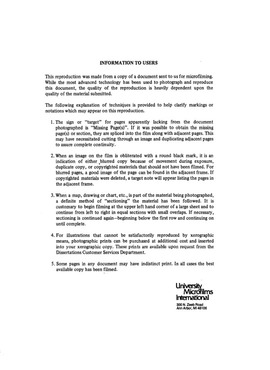| dc.contributor.author | Autry, Loretta Brown, | en_US |
| dc.date.accessioned | 2013-08-16T12:28:47Z | |
| dc.date.available | 2013-08-16T12:28:47Z | |
| dc.date.issued | 1982 | en_US |
| dc.identifier.uri | https://hdl.handle.net/11244/5061 | |
| dc.description.abstract | Results indicate that both the external and the self-monitoring procedures were effective in establishing and maintaining decreases in disruptive behaviors, and, to a lesser extent, increases in constructive behaviors. Substantiation of the second hypothesis regarding disruptive behaviors was obtained. Disruptive behaviors lowered through self-monitoring training were more enduring than those changed through observer monitoring. | en_US |
| dc.description.abstract | This problem intervention strategy targeted a total of forty ten, eleven and twelve year old males who were identified as disruptive in the classroom. Subjects were randomly assigned to one of three treatment groups, self-regulation to control disruptive behaviors (SR-) group, self-regulation to control constructive behaviors (SR+) group, external regulation (ER) group, or to the control group, no regulation (NR). Prior to effecting the experimental conditions, all subjects were administered the Intellectual Achievement Responsibility Questionnaire (IAR), to obtain a measure of their belief in reinforcement responsibility. The study was conducted in five phases, lasting a total of fifty-six days. Immediately after Phase V, all subjects were again administered the IAR. | en_US |
| dc.description.abstract | This study investigates the changes in locus of control orientations that may result from training in self-monitoring procedures to control behavior in the classroom. Three general hypotheses are tested. They are: (1) Within self-monitoring conditions students will show increased internality; (2) Within self-monitoring conditions students' disruptive behaviors will be reduced and will be maintained longer than lowered rates achieved through external monitoring; and (3) Within self-monitoring conditions students' constructive behaviors will be increased and will be maintained longer than increased rates achieved through external monitoring. | en_US |
| dc.description.abstract | Increased internality for the SR+, SR- and ER groups was significantly greater than that of the NR group. However, self-monitoring was not superior to external monitoring in increasing internal expectancies. It is speculated that since ER subjects knew that changing their behavior changed the level of reinforcement, even though monitored externally, they had reason to feel some internal control over the situation. | en_US |
| dc.description.abstract | The predicted superiority of the self-monitoring treatment over the externally monitored treatment in increasing constructive behaviors was not supported. . . . (Author's abstract exceeds stipulated maximum length. Discontinued here with permission of author.) UMI | en_US |
| dc.format.extent | vii, 127 leaves : | en_US |
| dc.subject | Education, Elementary. | en_US |
| dc.title | Locus of control and behavior management in the classroom. | en_US |
| dc.type | Thesis | en_US |
| dc.thesis.degree | Ph.D. | en_US |
| dc.thesis.degreeDiscipline | Jeannine Rainbolt College of Education | en_US |
| dc.note | Source: Dissertation Abstracts International, Volume: 43-12, Section: A, page: 3808. | en_US |
| ou.identifier | (UMI)AAI8306715 | en_US |
| ou.group | Jeannine Rainbolt College of Education | |
